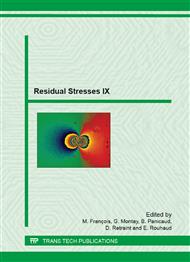p.562
p.568
p.574
p.580
p.586
p.592
p.598
p.603
p.609
Analysis of Residual Stress in Stress Harps of Grey Iron by Experiment and Simulation
Abstract:
Stress harps with bars of different size were used to study residual stresses due to different cooling rate during casting of a grey iron. Finite element (FE) simulations were performed to predict residual stresses from the casting process and the effect of a stress relieving heat treatment. Intended for validating the simulations, neutron diffraction (ND) and hole drilling methods were used to measure the residual stress distribution through the thickness and in a thin surface layer, respectively. Good agreement between the FE simulations and ND measurements is observed for the annealed harp and the normal and transverse directions of the as cast harp. Discrepancy occurs in the axial direction and especially in the side bars of the as cast harp for which the simulation shows much higher compressive residual stresses. The observed difference between the different techniques was discussed with respect to the characteristics of the different methods.
Info:
Periodical:
Pages:
586-591
Citation:
Online since:
August 2014
Permissions:
Share:
Citation:


